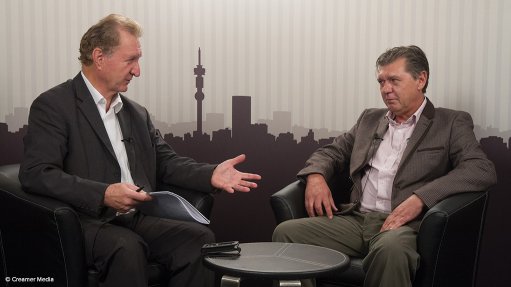
Anton Wheeler (right) with Martin Creamer
Photo by: Duane Daws
JOHANNESBURG (miningweekly.com) – The modernisation of South Africa’s mines and the extension of their lives are at the heart of a new government-backed local manufacturing body that will have access to a State-owned developmental cluster location, where joint development initiatives are envisaged.
The new organisation – Mining Equipment Manufacturing of South Africa, or Memsa – will run parallel to the recommendations of the Mining Phakisa as a Section 21 company with its own CEO.
The Mining Phakisa, which took place last year, placed emphasis on extending South Africa’s mining horizons through the introduction of advanced mining equipment.
The former Council for Scientific and Industrial Research site in Auckland Park, Johannesburg, will be made available to Memsa members, who currently number 20, for joint development initiatives.
The new Department of Trade and Industry-funded initiative will create a platform for local original-equipment manufacturers (OEMs) to work together on the development of specific equipment that will give mines the horizons that current methodology is unable to do.
Memsa members cover the wide range of equipment used in underground mines, ranging from trackless and rail-bound equipment to pump-driven equipment and battery-driven equipment.
Memsa chairperson Anton Wheeler, who is also MD of mining equipment manufacturing company Aard, told Creamer Media’s Mining Weekly Online that he had never seen government as involved with mining companies and local manufacturers.
“This is the beginning of a new process for South Africa,” Wheeler commented. (Also watch attached Creamer Media video).
Many government departments are promoting local manufacture and Wheeler sees the current period of commodity price slump as the ideal time for local mining OEMs to collaborate in the development of innovative local mining equipment in general, and ultra low profile (ULP) machines and extra low profile (XLP) machines for South Africa’s hard-rock narrow reef gold mines in particular.
Memsa members will conceivably also work with global OEMs on the localisation of global products into remotely controlled XLP and ULP equipment that will remove human beings from the vulnerable areas of mines.
Many manufacturers are already trialling XLP and ULP equipment and Wheeler’s own Aard has been supplying low-profile equipment to platinum and chrome miners on the western and eastern limbs of the Bushveld Complex, where stoping widths are 2 m wide.
But up to now, companies have been unable to tick all the boxes in narrow-reef, hard-rock stopes with widths of a metre and less.
FUEL CELLS
Platinum-using fuel cells are also likely to feature in new equipment, with Wheeler noting that a fuel cell driven ULP dozer is already operating in an Anglo American Platinum mine.
A second major platinum mining company is reportedly also taking steps to have a fuel cell operated load haul dump truck designed and developed for underground use.
Aard, which is owned 65% by previously disadvantaged South Africans, comes out of Anglo American’s Boart Longyear, which in the 1980s manufactured pneumatic rock drills for probably 90% of the South African market.
In 2008, Boart Longyear sold its mining capital equipment business to Aard, the biggest shareholders of which are Matasis, a company in which former Northern Cape premier Manne Dipico plays a leading role, and Nedbank Private Equity. (Also watch attached Creamer Media video).